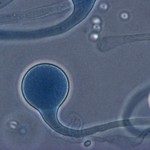Lien vers Pubmed [PMID] – 30465691
Lien DOI – 10.1139/gen-2018-0083
Genome 2019 Mar; 62(3): 160-169
With new or emerging fungal infections, human and animal fungal pathogens are a growing threat worldwide. Current diagnostic tools are slow, non-specific at the species and subspecies levels, and require specific morphological expertise to accurately identify pathogens from pure cultures. DNA barcodes are easily amplified, universal, short species-specific DNA sequences, which enable rapid identification by comparison with a well-curated reference sequence collection. The primary fungal DNA barcode, ITS region, was introduced in 2012 and is now routinely used in diagnostic laboratories. However, the ITS region only accurately identifies around 75% of all medically relevant fungal species, which has prompted the development of a secondary barcode to increase the resolution power and suitability of DNA barcoding for fungal disease diagnostics. The translational elongation factor 1α (TEF1α) was selected in 2015 as a secondary fungal DNA barcode, but it has not been implemented into practice, due to the absence of a reference database. Here, we have established a quality-controlled reference database for the secondary barcode that together with the ISHAM-ITS database, forms the ISHAM barcode database, available online at http://its.mycologylab.org/ . We encourage the mycology community for active contributions.



